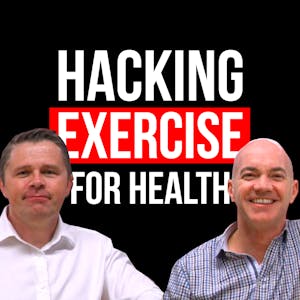Hacking Exercise For Health. The surprising new science of fitness.
Renowned exercise physiologists Martin Gibala and Stuart Phillips of McMaster University teach the surprising new science of cardio fitness and strength-building—and then provide you with hacks to get fit and strong (and healthy!) in less time than you ever thought possible. What’s the right mix of exercise between cardio and strength? How do you know if you’re working out hard enough? What’s better, heavy or light weights? These questions and more are addressed through a course designed to provide even the most inexperienced of exercisers the tools you need to design time-efficient workouts that can be done virtually anywhere, from your own home to a city park or even at your workplace. Marty and Stu are good friends and colleagues who just happen to be two of the world’s most passionate scholars in the science of fitness. They aim to entertain you while they’re describing the relationship between exercise and health. Marty is a pioneer in the field of interval training, the technique of varying your workout intensity to get fit faster than anyone ever thought possible. Stu’s studies proved that lifting lighter weights can be a highly effective strength-building technique—plus he’s a leading expert in dietary protein and muscle.
In Hacking Exercise for Health, you’ll follow Marty and Stu as they teach you the basics about the way your body boosts its fitness and strength. Next, they’ll apply that theory, providing you with a series of do-anywhere workouts and, most importantly, teaching you what you need to know to design your own sessions. Filled with inspirational practical tips, fun quizzes, interactive community participation and assignments designed to help you remember your lessons, Hacking Exercise for Health will give you the tools and techniques to incorporate exercise into your life, no matter how busy you are.
How to evaluate the role that physical activity plays in your health
How your cardiorespiratory fitness can be improved with aerobic training
How strength training results in strength gains and improve your health
How to formulate you own cardiorespiratory and musculoskeletal exercise routine to improve your health
Syllabus
Syllabus - What you will learn from this course
Week 1
The Basics of Fitness
Week 2
Cardiorespiratory Fitness
Week 3
Musculoskeletal Fitness
Week 4
Combining Cardio and Strength Fitness
FAQ
When will I have access to the lectures and assignments?
Access to lectures and assignments depends on your type of enrollment. If you take a course in audit mode, you will be able to see most course materials for free. To access graded assignments and to earn a Certificate, you will need to purchase the Certificate experience, during or after your audit. If you don't see the audit option:
What will I get if I purchase the Certificate?
When you purchase a Certificate you get access to all course materials, including graded assignments. Upon completing the course, your electronic Certificate will be added to your Accomplishments page - from there, you can print your Certificate or add it to your LinkedIn profile. If you only want to read and view the course content, you can audit the course for free.
Is financial aid available?
Yes. In select learning programs, you can apply for financial aid or a scholarship if you can’t afford the enrollment fee. If fin aid or scholarship is available for your learning program selection, you’ll find a link to apply on the description page.
Reviews
A very interesting course from beginning to the end. Content is really good and explanations are excellent. Thank you so much for the knowledge.
For those of us who are not Olympians, there is hope to stay in shape without spending hundreds of hours in the gym. This is a fun, yet useful mooc.
Un curso obligado para todo aquel que busque reafirmar conocimientos en el area de las ciencias de la salud de manera amena y basada en evidencias.
Es un curso bastante informativo y didáctico, sin embargo, me habría gustado profundizar en el ejercicio de fuerza y la importancia de la carga progresiva, etc
